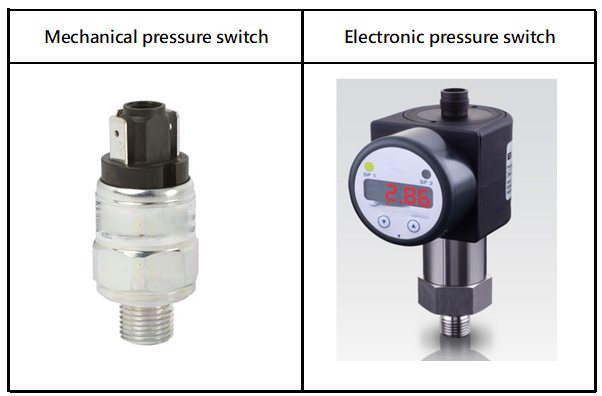A pressure switch is a mechanical or electronic device activated by the pressure of fluids, air, or gas when the fluids, air, or gasses reach a threshold or setpoint. The designs of pressure switches include bourdon tubes, pistons, diaphragms, or membranes that move or deform with the amount of pressure exerted by the system.

Pressure switches are comprised of several components including an adjustment screw, diaphragm, lever, and contacts. The components of a pressure switch are connected to one or more contacts in the switch. With enough force, a contact closes or opens the switch depending on its configuration. Although pressure switches have a variety of methods used to detect pressure, they can be primarily categorized as mechanical or electronic.

In a mechanical pressure switch, a diaphragm or a piston opens or closes a circuit when the pressure in the medium rises or drops to a certain value. Every time the pressure reaches the switch point, the diaphragm or piston transfers the pressure to a micro switch.
An electronic pressure switch is based on an electronic pressure sensor (often also referred to as a pressure transmitter) and therefore also provides its functionality. By virtue of the integrated electronic switches used to open or close the electric circuit, it performs simple control tasks.
Mechanical Switches are physical switches, which must be activated physically, by moving, pressing, releasing, or touching its contacts. Electronic Switches, on the other hand, do not require any physical contact in order to control a circuit. These are activated by semiconductor action.
Pressure switches are used in most industries employing compressed gas systems, HVAC, instrumentation systems, pumping systems, and so on.
Pressure switches are commonly associated with well pumps. Well pumps deliver the clean water to your house that you use for drinking, watering the garden. Pressure switches basically tell the pump when to turn on and when to turn off. Definition of a pressure switch : a device that monitors pressure and provides an output when a set pressure is reached. The specific pressure that opens and closes the switch is called the set point. Many residential pressure switches are designed for a minimum of 30 PSI and a maximum of 50 PSI. So in this example when the pressure in the system drops to 30 PSI, the switch activates and lets more water flow into the system. At 50 PSI, the switch turns off.
Pressure switches rely on water pressure to do all the work. The change in pressure that activates the switch is provided via the water from the well. The pressure moves up through the diaphragm which presses against a piston and spring, which in turn opens or closes the contacts. Open contacts located within the switch, and close them when the pressure drops. This completes an electrical circuit, which in turn activates the pump. When the set pressure is reached, this allows the contacts to open again which turns off the pump. Pressure switches are usually wired to a control box. Wires from the box are connected to separate terminals within the switch while other terminals are connected to a power supply.
We are pleased to share the information with you.
If you are interested in our pressure tank, please visit our website: www.aquaskyplus.com
Or, if you have any further questions, please feel free to contact us.
E-mail: [email protected]